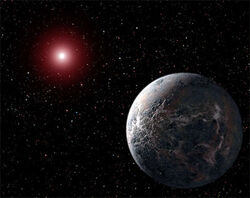| Kaventro | |
|---|---|
 Kaventro, orbiting around Trevidius. Its moons, Sigmus and Omegus, are not visible in this picture. | |
|
Location |
Trevidius System, Viperius Galaxy |
|
Planetary Class |
TGI |
|
Creator |
Styracosaurus Rider |
Kaventro is a terrestrial planet located in the Viperius Galaxy. It has not been fully settled, and only a few buildings exist on the surface.
Planetary Characteristics[]
Kaventro is similar to other life-bearing planets, but it has some differences as well.
(Note: All measurements are approximate. No precise measurements have ever been taken because the planet has never been fully colonized.)
Location and Position[]
Kaventro orbits its sun, Trevidius, at a distance of around 97 million miles, so it sits comfortably in the habitable zone.
Size[]
Kaventro is a relatively normal-sized planet, with an average radius of around 4000 miles, a circumference of around 250,000 miles, and a surface area of around 323,000,000 miles.
As of yet, no sapient species has evolved on or fully colonized the planet. But exploration by the Atrenids and the Salsene Grand Fleet have brought back spectacular images of the planet and its inhabitants.
History[]
Full article: History of Kaventro

The Terrortooth, the most infamous species on Kaventro
Kaventro was produced (approximately 7 billion BM) as its star formed and started to attract various pieces of rock and comet. Part of that material became this planet.
It survived the same cometary bombardment faced by most other new planets. Soon after, water appeared, and then it was only a matter of time before life evolved.
The earliest life on Kaventro lived in the oceans. At their most advanced form at the time, they were still eyeless, limbless, boneless, and mostly pigmentless.
Over time, life advanced into the form it holds today, and sapient species have explored the planet in the hopes of colonization.
Exploration[]
Kaventro was first discovered by the Salsenes. They sent probes down to the planet to investigate, but one was destroyed by Terrorteeth. They were about to abandon the mission when they met the Atrenids, who were also investigating. The two races formed an alliance to explore the apparent paradise, uncovering many strange lifeforms.
After this, news of the planet spread across the Viperius Galaxy. Not many actually visit the planet, because of the dangers, but a few poachers and pirates land to collect species illegally for the black market trade. The only permanent buildings on Kaventro are ranger stations in the Templum Archipelago to prevent this poaching.
Structure and Appearance[]

A Mercator projection of Kaventro. Note that this map shows only the biggest habitat regions.

A forest on Kaventro
The land on Kaventro consists of four continents: Magnus, Nikreli, Adjuctis, and Fuherzl.
Magnus[]
Magnus, the largest continent, is also generally regarded to be the most diverse in habitats. Some notable regions include:
- The Vermillion Hills
- The Snow Regions
- The Sharm Plains
Nikreli[]
Nikreli is a "double-continent," two landmasses held together by only a thin strip of land. Some notable regions include:
- The Epsilon Forest
- The Zartescan Jungle
- The Templum Archipelago (located off the coast)
Adjuctis[]
Adjuctis, the northernmost continent, is strictly polar. Little life exists here.
Fuherzl[]
Fuherzl is the smallest continent. The Ulurn Desert takes up the majority of the land area, but there are a few isolated plains and forests.
Unlike other life-bearing planets, which normally have several oceans, the water around the continents of Kaventro is regarded as one ocean, Lutrinus.
Satellites[]
Kaventro has two moons, Sigmus and Omegus. Sigmus is much smaller than Omegus, and has no major effect on the planet's geography or climate.
Life[]
Kaventro is filled with lifeforms. Some major groups include:
- Dolosids, lizard-like animals that have adapted to a wide range of habitats and diets
- Terunes, animals with relatively simple shapes without many protrusions but otherwise very diverse
- Natakals, flying creatures that dominate the planet's skies
- Arkenhyms, the main type of sea-dwelling animal
- Namans, large mammalian herbivores
Kaventro also hosts a wide variety of plants, such as nexsero and the snapperbud.